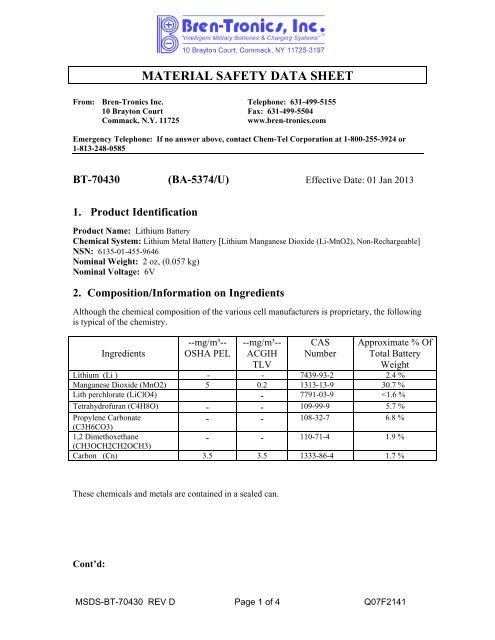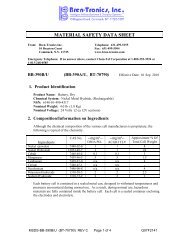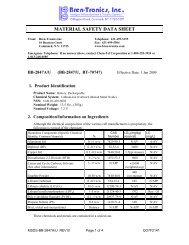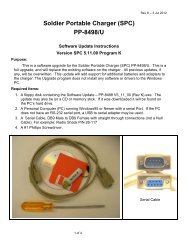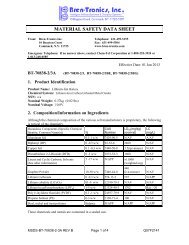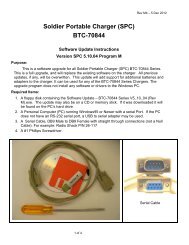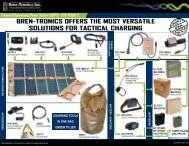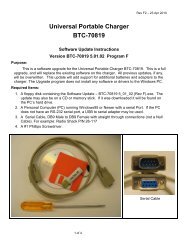You also want an ePaper? Increase the reach of your titles
YUMPU automatically turns print PDFs into web optimized ePapers that Google loves.
MATERIAL SAFETY DATA SHEET<br />
From: <strong>Bren</strong>-<strong>Tronics</strong> Inc. Telephone: 631-499-5155<br />
10 Brayton Court Fax: 631-499-5504<br />
Commack, N.Y. 11725<br />
www.bren-tronics.com<br />
Emergency Telephone: If no answer above, contact Chem-Tel Corporation at 1-800-255-3924 or<br />
1-813-248-0585<br />
BT-70430 (BA-5374/U) Effective Date: 01 Jan 2013<br />
1. Product Identification<br />
Product Name: Lithium Battery<br />
Chemical System: Lithium Metal Battery [Lithium Manganese Dioxide (Li-MnO2), Non-Rechargeable]<br />
NSN: 6135-01-455-9646<br />
Nominal Weight: 2 oz, (0.057 kg)<br />
Nominal Voltage: 6V<br />
2. Composition/Information on Ingredients<br />
Although the chemical composition of the various cell manufacturers is proprietary, the following<br />
is typical of the chemistry.<br />
Ingredients<br />
--mg/m³--<br />
OSHA PEL<br />
--mg/m³--<br />
ACGIH<br />
TLV<br />
CAS<br />
Number<br />
Approximate % Of<br />
Total Battery<br />
Weight<br />
Lithium (Li ) - - 7439-93-2 2.4 %<br />
Manganese Dioxide (MnO2) 5 0.2 1313-13-9 30.7 %<br />
Lith perchlorate (LiClO4) - 7791-03-9
3. Hazards Identification<br />
Do not short circuit, recharge, puncture, incinerate, crush, immerse, force discharge, or expose to temperatures above 85 C<br />
as there is risk of fire or explosion if doing so. This Lithium Manganese Dioxide battery contains sealed units which are not<br />
hazardous when used according to manufacturers recommendations.<br />
Under normal conditions of use, the electrode materials and electrolyte they contain are not exposed to the outside,<br />
provided the battery integrity is maintained and seals remain intact. Risk of exposure is only in case of abuse (mechanical,<br />
thermal, electrical) which leads to the activation of safety valves and/or rupture of the cell containers. Electrolyte leakage<br />
or battery vent /explosion /fire may follow, depending upon the circumstances.<br />
4. First Aid Measures<br />
Inhalation- Remove from exposure; rest and keep warm. In severe cases obtain medical attention.<br />
Skin Contact- Wash off skin thoroughly with tap water. Remove contaminated clothing and wash<br />
before reuse. In severe cases obtain medical attention.<br />
Eye Contact- Irrigate thoroughly with water for at least 15 minutes. Obtain medical attention.<br />
Ingestion- Wash out mouth thoroughly with water and give plenty of water to drink. Obtain medical attention.<br />
Further Treatment- All cases of eye contamination, persistent skin irritation and casualties who have swallowed any of this<br />
substance or been affected by breathing its vapors should see a doctor.<br />
5. Fire Fighting Measures<br />
Extinguishing Media: Use water or CO2 on burning cartons or batteries and intact cells.<br />
Special Fire Fighting Procedures:<br />
Cool fire-exposed batteries and adjacent structures with water spray from a distance.<br />
CO2 extinguishers or copious quantities of water or water based foam can be used to cool down burning batteries and cells as long as<br />
the extent of the fire has NOT progressed to the point that the lithium metal that they contain is exposed. For the general cool down do<br />
not use sand, dry powder, soda ash, graphite powder or fire blankets.<br />
Use only metal (Class D) extinguishers on raw lithium.<br />
6. Accidental Release Measures<br />
Ventilation: None under normal use conditions.<br />
Protective Gloves: None under normal use conditions. Use butyl gloves when handling leaking batteries.<br />
Eye Protection: None under normal use conditions. Wear safety glasses when handling leaking batteries.<br />
Earth or sand may be used to absorb any exudation. Seal leaking battery and earth in a heavy duty polyethylene bag and dispose of as<br />
special waste in accordance with local regulations.<br />
7. Handling and Storage<br />
Precautions to be taken in Handling and Storage:<br />
Do not short circuit, recharge, force discharge, immerse, puncture or crush.<br />
Store<br />
batteries in a cool, dry area. While the storage temperature range extends from -4°F to 122°F, (-20°C to +50°C), the battery<br />
longevity is maximized when stored at or below 70ºF (23ºC). Short term excursions higher than above temperature range<br />
(to 158ºF (70ºC) max) are allowable but may result in reduced battery service life. Do not place near heating equipment,<br />
ovens, etc.<br />
Potential Health Effects:<br />
These chemicals are contained in a sealed can. Risk of exposure occurs only if the battery is mechanically or electrically<br />
abused. The most likely risk is acute exposure when a cell vents. Propylene Carbonate is mildly<br />
irritating upon eye and skin contact. Contact of electrolyte and extruded lithium with skin and eyes should be<br />
avoided. Inhalation or ingestion of lithium trifluoromethane sulfonate may be harmful.<br />
Signs/Symptoms of Exposure:<br />
Skin and eye irritation may occur following exposure to a leaking battery.<br />
Medical Conditions Generally Aggravated by Exposure:<br />
An acute exposure will not generally aggravate any medical condition.<br />
<strong>MSDS</strong>-BT-70430 REV D Page 2 of 4 Q07F2141
8. Exposure Controls/Personal Protection<br />
Steps to be taken in Case Material is Released or Spilled:<br />
Notify safety personnel of large spills. Evacuate the area and allow vapors to dissipate.<br />
Increase ventilation. Avoid eye or skin contact. DO NOT inhale vapors. Clean up personnel should wear<br />
appropriate protective gear. Remove spilled liquid with absorbent and contain for disposal.<br />
In large fire situations, use self-contained breathing apparatus.<br />
9. Physical and Chemical Properties<br />
Appearance<br />
Odor<br />
Rectangular shape<br />
If leaking, smells of medical ether<br />
10. Stability and Reactivity<br />
Stability:<br />
Stable<br />
Conditions to Avoid:<br />
Do not heat, crush, disassemble, short-circuit or recharge.<br />
Hazardous Decomposition or By-products:<br />
Thermal degradation may produce hazardous fumes of manganese and lithium; Hydrofluoric acid; oxides of carbon<br />
and sulfur and other toxic by-products. Lithium metal reacts with water to produce highly flammable gases.<br />
Hazardous Polymerization:<br />
Will not occur.<br />
Incompatible Materials:<br />
Contents incompatible with strong oxidizing agents, alkalis, water.<br />
11. Toxicological Information<br />
Signs and symptoms- None, unless battery ruptures. In the event of exposure to internal contents, vapor fumes may<br />
be irritating to the eyes and skin. Inhalation- Lung irritant; Skin Contact- Skin irritant, Eye Contact- Eye<br />
irritantIngestion- Poisoning if swallowed, Target organs- nerves, liver snd kidneys.<br />
12. Ecological Information N/A<br />
13. Disposal Considerations<br />
Waste Disposal Method:<br />
No special precautions are required for small quantities. Large quantities of open batteries should be treated as<br />
hazardous waste. Dispose in accordance with local, state, and federal regulations. Do not incinerate, since batteries<br />
may explode at excessive temperatures.<br />
Cont’d:<br />
<strong>MSDS</strong>-BT-70430 REV D Page 3 of 4 Q07F2141
14. Transportation Information: This lithium battery is regulated as a Class 9 Misc hazardous material (dangerous<br />
goods). The UN number is UN 3090. The Lithium metal content per battery is 1.0g (0.5g/cell). The battery and component<br />
cells conform to the requirements of Section 38.3 of the UN Manual of Tests and Criteria, (T1-T8 tests). The battery must<br />
be packaged and shipped according to the following regulations:<br />
Domestic Transportation within the U.S. - All Modes: See 49 CFR Section 173.185 and Special Provision 189:<br />
Battery is “excepted” from Class 9 Hazardous Materials Regulations because it contains maximum of 2g of Lithium metal.<br />
Battery must be packaged in a manner TO PREVENT SHORT CIRCUITS and in a strong outer package. Each package<br />
must be marked with the following statement: “LITHIUM METAL BATTERIES – FORBIDDEN FOR TRANSPORT<br />
ABOARD PASSENGER AIRCRAFT”. For quantities of 13 or more in one package, additionally: 1) mark “LITHIUM<br />
BATTERIES INSIDE" on the package and that special procedures should be followed if package is damaged; (or IATA<br />
label shown below); 2) Accompany with a document indicating same information; 3) Package must be capable of being<br />
dropped 1.2 meters in any orientation without damage to cells or batteries contained in the package, without shifting of the<br />
contents that would allow short circuiting, and without release of package contents; 4) The maximum gross weight of the<br />
package may not exceed 30 kg (66lbs). Note: these requirements will reflect Int’l regs below later in 2013. However, some<br />
U.S. carriers may require compliance now.<br />
International Transportation – All Modes: ADR, IMDG Code, ICAO Technical Instructions, IATA Dangerous<br />
Goods Regulations:<br />
ADR and IMDG Code, Special Provision 188: Battery is “excepted” from Class 9 Dangerous Goods Regulations<br />
because it contains maximum of 2g of Lithium metal. Battery must be packaged in a manner TO PREVENT SHORT<br />
CIRCUITS. Battery must be packed in inner packagings that completely enclose the battery, then placed in a strong outer<br />
package capable of withstanding a 1.2m drop test in any orientation without damage to the batteries, shifting of contents to<br />
allow battery to battery contact or release of contents. If shipping to or from US, use above “… - FORBIDDEN …”<br />
statement. Package also must carry label similar to the IATA lithium battery handling label shown below. Package must be<br />
accompanied with a document such as an air waybill with an indication that: the package contains lithium metal batteries,<br />
must be handled with care, that a flammability hazard exists if the package is damaged, special procedures should be<br />
followed in the event the package is damaged, to include inspection and repacking if necessary, and a telephone number for<br />
additional information. Package may not exceed 30 kg (66 lbs) gross weight.<br />
IATA Dangerous Goods Regulations / ICAO Technical Instructions: Packing Instruction 968, Section II.<br />
No more than 2 batteries per package. Packaging and documentation requirements are same as shown above for IMDG<br />
and ADR. IATA and ICAO specifically require lithium metal handling label shown below. If shipping to or from US, use<br />
above “… - FORBIDDEN …” statement. No package weight limit.<br />
IATA Dangerous Goods Regulations / ICAO Technical Instructions: Packing Instruction 968, Section IB.<br />
More than 2 batteries per package. Packaging and documentation requirements are same as shown above for IMDG Code<br />
and ADR and package must carry Class 9 label, Cargo Aircraft Only label, and lithium battery handling label shown below.<br />
In addition, shipment must be offered to airline as fully-regulated Class 9 dangerous goods, accompanied with shipper’s<br />
declaration for dangerous goods (or alternative document with similar entries) and employees must have dangerous goods<br />
training. Package may not exceed 2.5 kg (5.5 lbs) gross weight.<br />
15. Regulatory Information<br />
Batteries are considered to be “articles” and thus are exempt from TSCA regulation.<br />
16. Other Information<br />
Avoid mechanical or electrical abuse. DO NOT short circuit or install incorrectly. Batteries may explode, pyrolize or vent<br />
if disassembled, crushed, recharged or exposed to high temperatures. Install batteries per equipment instructions.<br />
This information and recommendations set forth are made in good faith and believed to be accurate as of the date of preparation. <strong>Bren</strong>‐<strong>Tronics</strong> Inc.<br />
makes no warranty, expressed or implied, regarding the accuracy of the data or the results to be obtained from the use thereof.<br />
<strong>MSDS</strong>-BT-70430 REV D Page 4 of 4 Q07F2141


